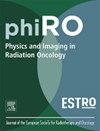利用初始治疗方案信息实现质子弧治疗方案的快速适应
IF 3.3
Q2 ONCOLOGY
引用次数: 0
摘要
背景与目的质子弧治疗(PAT)是一种提供连续旋转质子束的新兴治疗方式。目前的PAT规划方法非常耗时,不适合在线调整。本研究提出了一种适应PAT计划的加速工作流程。材料和方法提出的工作流将点从初始CT转移到当天的CT,根据初始模式更新能量层,并根据其初始权重和对目标函数的影响重新优化所选择的转移点。回顾性研究了5例头颈部患者在重复CT上进行了计划适应。在重复CT上使用两种不同的方法生成PAT计划:参考(从头创建)和智能适应(使用建议的自适应工作流生成)。对所有方案进行鲁棒优化。结果智能适应方案对危险器官的平均剂量与参考相似:下颌平均剂量中位数增加最大,为1.9 Gy;智能适应方案的脊髓最大剂量中位数低0.5 Gy。智能适应方案对原发肿瘤和淋巴结的中位目标覆盖率(即D98)在正常情况下分别下降0.2和0.4 Gy,在最坏情况下分别下降0.4和0.6 Gy;所有明智的计划都达到了临床目标。智能自适应方法将平均规划时间从19184秒减少到5626秒,提高了3.4倍。结论智能适应方案与参考方案质量相近,同时显著缩短了新患者解剖方案生成时间。本文章由计算机程序翻译,如有差异,请以英文原文为准。
Towards faster plan adaptation for proton arc therapy using initial treatment plan information
Background and Purpose
Proton arc therapy (PAT) is an emerging modality delivering continuously rotating proton beams. Current PAT planning approaches are time-consuming, making them unsuitable for online adaptation. This study proposes an accelerated workflow for adapting PAT plans.
Materials and Methods
The proposed workflow transfers spots from initial computed tomography (CT) to the CT of the day, updates energy layers considering the initial pattern, and re-optimizes selected transferred spots based on their initial weights and impact on the objective function.
A retrospective study was conducted on five head and neck patients who underwent plan adaptation on a repeated CT. PAT plans were generated with two different methods on the repeated CT: reference, created de novo, and smart-adapted, generated with the proposed adaptive workflow. Robust optimization was performed for all plans.
Results
Smart-adapted plans achieved similar mean dose to organs at risk as the reference: the largest median increase of mean dose was 1.9 Gy to the mandible; the median of maximum dose to spinal cord was 0.5 Gy lower for the smart-adapted plans. The median target coverage, i.e. D98, to primary tumor and nodes of smart-adapted plans decreased by 0.2 and 0.4 Gy for the nominal case, and 0.4 and 0.6 Gy for the worst-case scenario; all smart-adapted plans met clinical objectives. The smart-adaptation method reduced average planning time from 19184 s to 5626 s, a 3.4-fold improvement.
Conclusions
Smart-adapted plans achieve similar plan quality to the reference method, while significantly reducing plan generation time for new patient anatomy.
求助全文
通过发布文献求助,成功后即可免费获取论文全文。
去求助
来源期刊

Physics and Imaging in Radiation Oncology
Physics and Astronomy-Radiation
CiteScore
5.30
自引率
18.90%
发文量
93
审稿时长
6 weeks
 求助内容:
求助内容: 应助结果提醒方式:
应助结果提醒方式:


